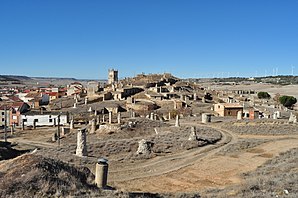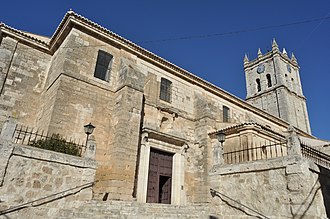Baltanás
| Baltanás parish | ||
|---|---|---|
 Baltanás - View of the town with bodegas and church
|
||
| coat of arms | Map of Spain | |

|
|
|
| Basic data | ||
| Autonomous Community : |
|
|
| Province : | Palencia | |
| Comarca : | El Cerrato | |
| Coordinates | 41 ° 56 ′ N , 4 ° 15 ′ W | |
| Height : | 785 msnm | |
| Area : | 158.85 km² | |
| Residents : | 1,191 (Jan 1, 2019) | |
| Population density : | 7.5 inhabitants / km² | |
| Postal code : | 34240 | |
| Municipality number ( INE ): | 34022 | |
| administration | ||
| Website : | Baltanás | |
Baltanás is a place and a northern Spanish municipality (municipio) with 1,191 inhabitants (at January 1, 2019) in the province of Palencia of the Autonomous Community of Castile and Leon .
Location and climate
Baltanás is in the old Castilian Meseta at an altitude of approx. 785 m . The provincial capital Palencia is located approx. 27 km (driving distance) to the west; the cities of Burgos and Valladolid are approx. 80 km to the north-east and a good 60 km to the south-west. The climate in winter is cool, in summer, despite the altitude, it is temperate to warm; Precipitation (approx. 460 mm / year) falls mainly in the winter half-year.
Population development
| year | 1857 | 1900 | 1950 | 2000 | 2018 |
| Residents | 2,593 | 2,439 | 2,817 | 1,561 | 1,216 |
The significant population decline that has been observed since the middle of the 20th century is mainly due to the mechanization of agriculture and the abandonment of small farms and the resulting loss of jobs. The hamlet (pedanía) Valdecañas de Cerrato , which still has around 50 inhabitants, also belongs to the municipality .
economy
In earlier times, the residents of the place and the entire mountain region lived almost without exception as self-sufficient on the yields of their fields and gardens; viticulture and cattle breeding were also practiced. Small traders, craftsmen and service providers of all kinds have settled in the village itself centuries ago. Baltanás is now part of the Arlanza (DO) wine-growing region . At the beginning of the 21st century, a wind farm was installed on a nearby hill .
history
The origins of the place possibly lead back to the Celtic tribe of the Vaccaei ; from the 2nd century BC The Roman influence became stronger and stronger. However, there are no traces of these as well as of the Visigoths and the Moors in Baltanás itself. Historically, the place only becomes more tangible at the end of the 9th century, when the Asturian King Alfons III. as part of the Reconquista advanced into the area and had a castle (castillo) built near Baltanás, which has largely disappeared today . The first written mention of the place name comes from the year 1030. In the 15th century the administrative area of the Merindad de Cerrato with the main town Palenzuela arose, but Baltanás also experienced a political and economic heyday in the 16th century.
Attractions
- The Iglesia de San Millán is dedicated to St. Aemilianus of Cogolla and was built in the 16th century at the highest point of the place; In addition, it is surmounted by an imposing bell tower (campanario) with ornamental obelisks . The three equal ships of the Renaissance church are of late Gothic clustered piers separated and stellar vaults covered; Renaissance forms can be found mainly on the west gallery. The baroque main altar should be emphasized .
- The in 17./18. Ermita de Revilla , built in the 18th century, stands on the outskirts; it is surmounted by a bell gable (espadaña) . The portal is on the south side. The interior has a single nave, but has a transept and a domed crossing .
- The Museo del Cerrato , housed in the former Hospital de Santo Tomás , contains numerous finds from the region.
- In the hill on the outskirts, interspersed with small pieces of rock, there are numerous cellars ( bodegas ) ; The chimney-like ventilation shafts are striking.
- Surroundings
- In 2010, the late Roman-Visigoth necropolis of La Poza was excavated about 2 km northwest of today's location . Numerous sarcophagi and stone box tombs were discovered; there are also references to a location. The most important finds can be seen in the Museo del Cerrato .
- Valdecañas de Cerrato
- The townscape and the Iglesia de San Nicolás de Bari in the hamlet of Valdecañas de Cerrato are pretty pretty .
Web links
- Baltanás, sights - short information (spanish)
Individual evidence
- ↑ Cifras oficiales de población resultantes de la revisión del Padrón municipal a 1 de enero . Population statistics from the Instituto Nacional de Estadística (population update).
- ↑ Baltanás - climate tables
- ↑ Baltanás - Population Development
- ↑ Baltanás - Church
- ↑ Baltanás Museum



